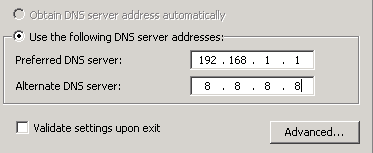How to do DNS correctly
Time and again people seem to be doing DNS outside of best practice rules so I thought it might be a good time to go through how DNS works, what DNS best practice is (with regards to a windows environment) and why it's like that.
In a nutshell, the most common mistake I see with DNS configuration is this:
This configuration is put in place for one of two reasons:
1. It is there to resolve external addresses should the internal fail for some reason.
2. It is there because there is only one internal DNS server.
Point 1 is the most common that I come across and it's very wrong because that is not how DNS works.
When a name query is run, DNS will ask the first name server to handle it, if that name server replies and says "I don't know what that name is that you've sent me", that's it. DNS will not ask the second DNS server because it has a valid reply. Yes, negative replies are valid replies. They are even cached locally for a period of time. All of this is covered in RFC 2308.
Point 2 appears to make some sense, if there is only one internal DNS server and that dies then queries to it fail but, hey, at least people can still get on the internet - right?
Well yes but.... Every now and then that first DNS server is going to be too busy to reply so the client will ask the second DNS server. If the query is for an internal resource then the second DNS server won't know about it and suddenly you've got this weird condition where a client appears to be refusing to ask the internal DNS server and nothing internally is being resolved, again this is due to the cached negative responses covered in point 1.
Best practice is always to have your clients use internal DNS servers and it's always best practice to have two internal DNS servers.
The second big configuration error that I see is people using internal name servers in the forwarders. This is utterly pointless as the forwarder is there to handle queries that your internal DNS servers cannot. So, internally if you ping www.google.com your internal DNS servers won't know what that is so will pass it on to the forwarder.
If your forwarders are just internal servers then the query will either take a long time to complete (i.e. until it gets out of the network) or it'll just fail.
In summary, Internal DNS server IP addresses for clients, forwarders on the DNS servers for everything else. Stick to that and DNS shouldn't ever be a problem.
Subscribe to Ramblings of a Sysadmin
Get the latest posts delivered right to your inbox
